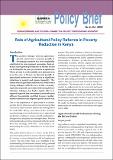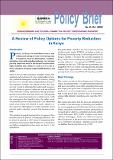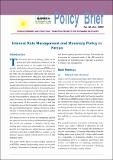| dc.date.accessioned | 2023-01-25T12:51:45Z | |
| dc.date.available | 2023-01-25T12:51:45Z | |
| dc.date.issued | 2001 | |
| dc.identifier.uri | https://repository.kippra.or.ke/handle/123456789/4053 | |
| dc.description.abstract | This brief provides a bird’s-eye view of the KIPPRA-Treasury Macro Model
(KTMM) and its importance in policy analysis. KTMM is built mostly along the
now fairly standard lines of the aggregate demand aggregate supply framework. The
model is demand driven in the short run, with multiplier effects through consumption
and investment and the external sector. An important assumption of this model is
that any demand is actually met, that is, we assume that the price system ensures that
there is always some excess capacity in the economy. This assumption is justified by
the liberalised nature of the Kenyan economy. The model is designed in such a way
that it tends to return to equilibrium with 'normal' capacity use and unemployment
rates in the medium and long run. The main feedback mechanisms in the real
economy work through the wage-price spiral, the interest rate and the real exchange
rate. | en |
| dc.language.iso | en | en |
| dc.publisher | The Kenya Institute for Public Policy Research and Analysis (KIPPRA) | en |
| dc.relation.ispartofseries | Policy Brief;No. 08 of 2001 | |
| dc.subject | Treasury Macro Model | en |
| dc.subject | Policy Analysis | en |
| dc.subject | Policy Forecasting | en |
| dc.subject | Aggregate Supply Framework | en |
| dc.subject | Price System | en |
| dc.title | Policy Brief No. 08 of 2001 on The KIPPRA-Treasury Macro Model: A New Instrument for Policy Analysis and Forecasting | en |
| dc.type | Other | en |
| ppr.contributor.author | The Kenya Institute for Public Policy Research and Analysis (KIPPRA) | en |




